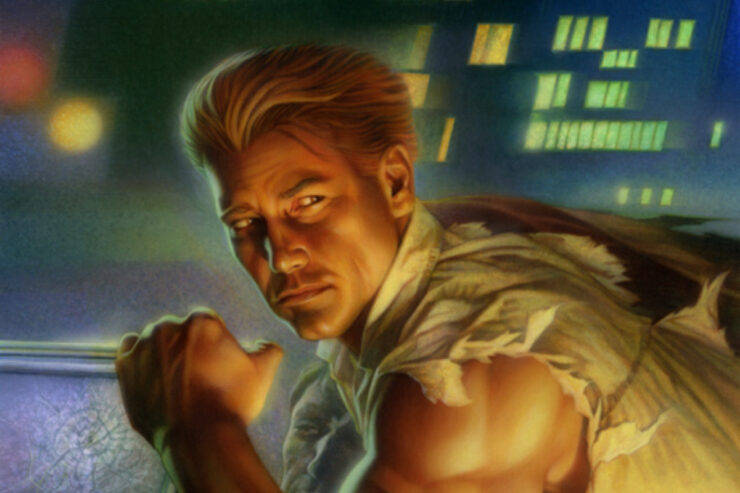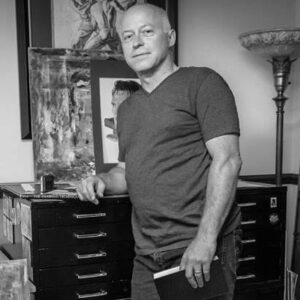 Pulp magazines have influenced writers, artists, film directors, software developers, and countless others over the years. Our “PulpFest Profiles” focus on contemporary creators who have drawn inspiration from these rough-paper fiction magazines.
Pulp magazines have influenced writers, artists, film directors, software developers, and countless others over the years. Our “PulpFest Profiles” focus on contemporary creators who have drawn inspiration from these rough-paper fiction magazines.
Artist Douglas C. Klauba has depicted many of the great popular heroes of the 20th Century, including a host of pulp magazine titans.
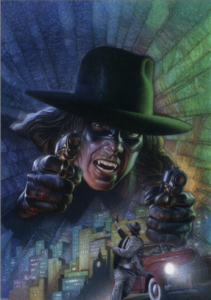 Craig McDonald (CMC): You have painted sublime and powerful images of The Avenger, Doc Savage, The Shadow, The Spider, Batman, The Green Hornet, Flash Gordon, The Phantom, The Domino Lady, Zorro, and others. Many of your works also reflect pulp and film noir/hardboiled sensibilities. Is there a pulp or pulp-adjacent character who remains on your bucket list?
Craig McDonald (CMC): You have painted sublime and powerful images of The Avenger, Doc Savage, The Shadow, The Spider, Batman, The Green Hornet, Flash Gordon, The Phantom, The Domino Lady, Zorro, and others. Many of your works also reflect pulp and film noir/hardboiled sensibilities. Is there a pulp or pulp-adjacent character who remains on your bucket list?
Douglas C. Klauba (DCK): Thank you! I appreciate that. I just try and do good work! Well, I have been doodling sketches of Conan, Kull, and Valeria on occasion. They have been on my mind for a while. I just haven’t had the available time to work on any concrete ideas so far. And if I were to share my past high school notebooks with you from my teen years, there would be sketches of Conan and barbarians in the back of those notebooks. So, I have a very long admiration for Robert E. Howard’s characters that I became immersed in through the Marvel Comics series, the magazine, and then later with the actual books. On the other end of my bucket list, you would find detectives like Perry Mason. I was inspired by the recent HBO series — which was so satisfying and hit all the bullet points for me. I really enjoy painting hard-boiled, detective pieces — but again, can’t find the available time to squeeze one into my schedule at the moment. Although, I am doing my best to shift things around to find the time!
CMC: Is there a classic pulp character among those you’ve already portrayed whom you particularly savor depicting?
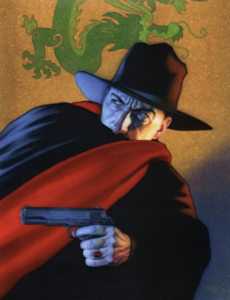 DCK: That’s another loaded question! Let’s see . . . I remain an Edgar Rice Burroughs fan, and probably always will be. I am grateful to be associated with a few of those characters such as John Carter, Dejah Thoris, Carson of Venus, and Tarzan — and will always be beside myself to get opportunities with anything by ERB. I have been a John Carter fan just as long as I have been a Conan fan. Those were early reading interests that started with the Marvel Comics series. I later went on to read the original stories. I still have a few John Carter sketches in my sketchbook that I would like to develop into paintings. And I have been reading a little more Tarzan, since working on the recent Jeff Mariotte novel for ERB, Inc. So, I’ve been sketching Tarzan, as well. But, then there is The Shadow! I have yet to officially paint The Shadow for a license holder, either for a cover or poster. The Shadow pulp and paperback artwork have always been a big influence. I would really love the opportunity to do a Shadow cover.
DCK: That’s another loaded question! Let’s see . . . I remain an Edgar Rice Burroughs fan, and probably always will be. I am grateful to be associated with a few of those characters such as John Carter, Dejah Thoris, Carson of Venus, and Tarzan — and will always be beside myself to get opportunities with anything by ERB. I have been a John Carter fan just as long as I have been a Conan fan. Those were early reading interests that started with the Marvel Comics series. I later went on to read the original stories. I still have a few John Carter sketches in my sketchbook that I would like to develop into paintings. And I have been reading a little more Tarzan, since working on the recent Jeff Mariotte novel for ERB, Inc. So, I’ve been sketching Tarzan, as well. But, then there is The Shadow! I have yet to officially paint The Shadow for a license holder, either for a cover or poster. The Shadow pulp and paperback artwork have always been a big influence. I would really love the opportunity to do a Shadow cover.
CMC: How do you go about creating your own version of a well-known, legacy-pulp character, such as Doc Savage?
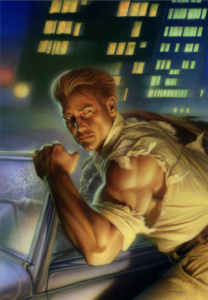
DCK: It usually begins with a conversation with the publisher or art director. I enjoy working through the creative process to arrive at a successful conclusion. I’ll do rough thumbnail sketches. I’ll explore what has already been done and do some drawings based on the history of the character. Most likely I’ll know what other artists have done before me, and see what was successful and what doesn’t work for me. When I painted the Doc Savage Radio Scripts cover for the Moonstone edition, Joe Gentile, the publisher, and I discussed what this depiction would be.
We both agreed that it would be my interpretation of the Walter Baumhofer Doc Savage, as his appearance in a radio drama would be more in line with that old-time radio show era and resemble the classic pulp style. And quite honestly it was really a challenge because it had to look like Doc Savage. If a prospective reader wasn’t aware of this classic pulp style, it’s my job to make sure it comes off in a contemporary and impactful interpretation or homage. Yet the art should look familiar to a Doc Savage pulp or paperback fan.
Luckily, I used my friend, Jack Juka, as my “go-to” when I was working on The Frightened Fish cover. He would give me his honest opinion. Jack is a huge Doc Savage fan and one of the greatest guys you can meet. Jack saw my radio script cover at the Moonstone booth at the New York Comic Con. He convinced Joe Gentile to call me at the show so he could talk to me since I wasn’t there. Jack went on to say how much he loved my cover, asked if the original was available, and bought it. I was thrilled that someone understood what I had depicted. Jack and I had many more conversations about Doc Savage, the covers, the artists, and more. We’ve been friends ever since!
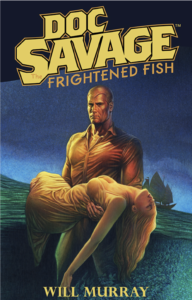 CMC: Staying with Doc Savage for a moment, you’ve created a rather Bantam paperback-like version complete with widow’s peak for a Will Murray cover. You created that classic, pulp-style take on Doc for a Moonstone anthology of Doc Savage radio scripts. You’ve also recently created an illustration for a pastiche version of Doc for a Win Scott Eckert/Philip José Farmer collaboration. What is your strategy for coming at all of these different spins on the same core vintage pulp magazine character?
CMC: Staying with Doc Savage for a moment, you’ve created a rather Bantam paperback-like version complete with widow’s peak for a Will Murray cover. You created that classic, pulp-style take on Doc for a Moonstone anthology of Doc Savage radio scripts. You’ve also recently created an illustration for a pastiche version of Doc for a Win Scott Eckert/Philip José Farmer collaboration. What is your strategy for coming at all of these different spins on the same core vintage pulp magazine character?
DCK: Those were all based on conversations with the publishers. Artists have to know the history before creating anything with the character so that we can approach each project with originality. I worked pretty closely with Joe Gentile, and he relayed what Will was looking for with the appearance of Doc Savage for the Moonstone edition of The Frightened Fish.
I spoke directly with Win when I started to develop ideas for The Monster On Hold. Win and I went back and forth with emails, thumbnails, and a video call. It was a great way to connect and work. I listened to what Win was saying, and you know, Win would say the figure would be like this, the other figure would be like that, the colors would be like a Bama palette.
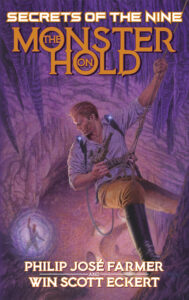 You have to know what the client is saying. Read between the lines sometimes. Think about the visuals that they’re describing and where they may have come up with those ideas. What were they looking at that influenced the cover idea? I’ll use the client’s description and discussion as the base of the foundation. Then I build upon that, and I will lead their idea or ideas to where they wanted them to go. Some ideas remain and some get carved away as I move forward. The concepts’ strongest ideas and visuals will remain. I don’t know if that makes sense to anyone but me. But, that’s a little bit of my thinking process.
You have to know what the client is saying. Read between the lines sometimes. Think about the visuals that they’re describing and where they may have come up with those ideas. What were they looking at that influenced the cover idea? I’ll use the client’s description and discussion as the base of the foundation. Then I build upon that, and I will lead their idea or ideas to where they wanted them to go. Some ideas remain and some get carved away as I move forward. The concepts’ strongest ideas and visuals will remain. I don’t know if that makes sense to anyone but me. But, that’s a little bit of my thinking process.
Once a thumbnail is approved and we know the direction to move forward with, I will develop a tight pencil drawing, from photo references, so everyone can visualize what the cover will look like when completed. Beyond a pencil drawing that is presented, I will inject mood for an emotional response into the painting process.
CMC: In portraying Doc in these various iterations, it also appears you’ve not attempted to echo or even suggest the features of longtime Doc Savage model Steve Holland as many post-Bama Doc artists have chosen to do. Was that a conscious choice?
DCK: Well, as I said, I am aware of what has been done before me. I am very familiar with the Steve Holland photographs. I’ve gone over the photos and paintings to study the process of Bama with the Doc Savage paintings. Beautiful stuff. And at first, my visual instinct might be: “Holy cow! These photos are inspiring! They’re explosive, I can draw from these!”
The Bama paintings are iconic, heroic, and hugely influential. I mean, how can they not be? The impact of what Bama, and even what Larkin did later on with the Doc Savage covers, have left a lasting impression on us. But, ethically, I shouldn’t use those! They are not mine. I didn’t shoot those references. Those were shot for James Bama’s ideas. So I would just absorb them and be inspired by them.
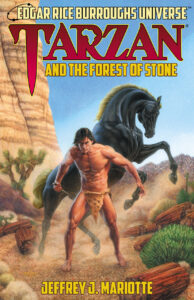 I will say that comic book artists would dive head first into that area of echoing Bama covers or Steve Holland with that visual instinct. That’s just the nature of the current comic book industry. But, I look for what I can do with the character and the project on its own merit. Many times I hear my past teachers in my mind . . . like Drew Struzan, Kazu Sano, or Thomas Blackshear. They would say, “Don’t do what I did, don’t do what they did. No one will do it as well as you can.” So I think along that line. I’ll follow my vision. I don’t want to copy what Bama did. I simply use his work as a guide to making good choices that the audience will connect with.
I will say that comic book artists would dive head first into that area of echoing Bama covers or Steve Holland with that visual instinct. That’s just the nature of the current comic book industry. But, I look for what I can do with the character and the project on its own merit. Many times I hear my past teachers in my mind . . . like Drew Struzan, Kazu Sano, or Thomas Blackshear. They would say, “Don’t do what I did, don’t do what they did. No one will do it as well as you can.” So I think along that line. I’ll follow my vision. I don’t want to copy what Bama did. I simply use his work as a guide to making good choices that the audience will connect with.
It’s the same when I’m doing John Carter, Dejah Thoris, and Tarzan. There’s A LOT of art that has come before anything that I am about to do. I mean, Frazetta, alone! The pressure I felt was daunting when I worked on Tarzan. With all of those Joe Jusko paintings in front of us! I had to say to myself, those are your guides. Where can you go with that? Sometimes it’s like jumping without a net. But, that just helps with the challenge and the thrills of working with these characters.
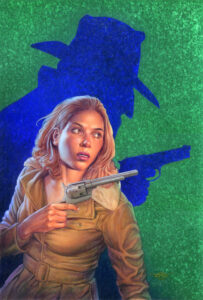 CMC: Can we further explore your process of putting your own spin on long-established characters? Perhaps we could focus on your creation of “Zana O’Savin,” the pastiche version I’m writing of Pat Savage and which you illustrated for a summer 2022 release. I sent you some brief descriptive passages from the novel, and a rather broad image concept. What’s your process in terms of steps toward the final painting?
CMC: Can we further explore your process of putting your own spin on long-established characters? Perhaps we could focus on your creation of “Zana O’Savin,” the pastiche version I’m writing of Pat Savage and which you illustrated for a summer 2022 release. I sent you some brief descriptive passages from the novel, and a rather broad image concept. What’s your process in terms of steps toward the final painting?
DCK: Craig, you gave me a lot of material to begin with. Which I was thankful for, and I think every commission should receive at the beginning of a project. It’s better than searching for more info. I would rather be over-informed than given barely anything. Jim Steranko echoed that to me during a conversation.
One thing that scares me is when someone says they are giving me complete freedom. That hardly works. I would end up developing something that you would be a little disappointed with.
Recently, I worked on a “Midnight Guardian” cover for John Bruening. He presented a clear concept of what he was interested in, with a lot of follow-up information. And then, I continued to ask him for more information, and more conversation. Thank God for his patience with me. But, I really needed to connect with the concept. I didn’t know how much information was enough information. But, the “ah-ha!” moment eventually came from all of that digging! There were at least 24 thumbnail roughs before a design grabbed me and John so that I could move forward.
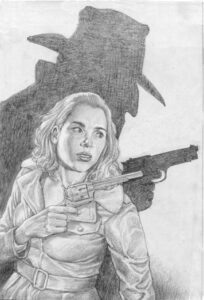 But back to Zana . . . from there it was all about the right image, characterization, and cover design. Once you and I nailed down the idea and thumbnail rough I picked my model and started my drawing. I was looking for a specific facial expression that would reflect her character. So for Zana, I looked into my backlog of photos that I already had from a particular model I’ve used. She is one of my favorite models and I knew I had something in my files of her that could be used. I began working on my studies, and drawing is my favorite part. It’s the hard work, the foundation. It’s such a thrill for me! If the drawing isn’t working, I won’t even begin the painting. That happened on Tarzan and The Forest of Stone for ERB, Inc. I wrestled with the drawing until I was happy. I did lots of drawings and studies. Even scrapping the initial figures and design and starting new. You have to be committed to the very end.
But back to Zana . . . from there it was all about the right image, characterization, and cover design. Once you and I nailed down the idea and thumbnail rough I picked my model and started my drawing. I was looking for a specific facial expression that would reflect her character. So for Zana, I looked into my backlog of photos that I already had from a particular model I’ve used. She is one of my favorite models and I knew I had something in my files of her that could be used. I began working on my studies, and drawing is my favorite part. It’s the hard work, the foundation. It’s such a thrill for me! If the drawing isn’t working, I won’t even begin the painting. That happened on Tarzan and The Forest of Stone for ERB, Inc. I wrestled with the drawing until I was happy. I did lots of drawings and studies. Even scrapping the initial figures and design and starting new. You have to be committed to the very end.
CMC: Are there any vintage pulp illustrators who particularly inspire you or whom you especially admire?
DCK: Virgil Finlay, George Rozen, Walt Baumhofer, and Hubert Rogers. George Rozen has been a favorite since I was a young comic book reader and I came across The Shadow covers. It seems I’ve always had Virgil Finlay art around. I would pick up early fanzine publications with his work. And the circle of friends that I grew up with was aware of Finlay. So I was most likely influenced by their admiration of his work as well. I was fortunate to grow up with a group of like-minded friends who were creative and interested in the same stuff. We would plan and publish our fanzines, including a Doc Savage fan magazine. We covered everything from Marvel to the pulps, and the movie. That’s when I noticed the Baumhofer covers and we would compare what Bama did against those earlier covers.
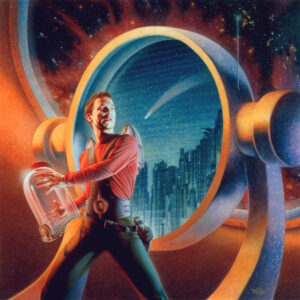 As for Hubert Rogers, his artwork grabbed me visually, even before I knew his name. His work was influential in my earlier illustration career when I was working more in advertising illustration and I started to develop a more specialized portfolio that was more in line with my heroic, pulp sensibilities. My first successful painting inspired by Hubert Rogers was my Buck Rogers painting that was commissioned for Chicago’s Adler Planetarium and Space Museum.
As for Hubert Rogers, his artwork grabbed me visually, even before I knew his name. His work was influential in my earlier illustration career when I was working more in advertising illustration and I started to develop a more specialized portfolio that was more in line with my heroic, pulp sensibilities. My first successful painting inspired by Hubert Rogers was my Buck Rogers painting that was commissioned for Chicago’s Adler Planetarium and Space Museum.
CMC: You’ve also painted images for “new-pulp” works, including “The Midnight Guardian” series by John Bruening that you referenced earlier. Have you ever toyed with creating your own neo-pulp-style hero or heroine for comics, perhaps?
DCK: Oh sure I have. And I haven’t abandoned my ideas. I continuously work on that “special project” of mine, here and there. I’m doing it for myself, at the moment. Just for the enjoyment. I’ll finish part of it one day soon, so I can release it. Unfortunately, my schedule doesn’t give me enough time to work on it very regularly.
CMC: You’ve had many powerful illustrations built around The Phantom. Is there anything on the horizon with this character?
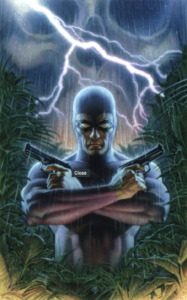 DCK: Well, there always seems to be something in the works with The Phantom. Because of the multiple license holders, I never know where I’ll land. There has been a rumored Art of The Phantom book in the works from a publisher, but I am unsure where that is at the moment. Last year I was honored with creating a cover for the 2022 Phantom Diary from Mallon Publishing in Australia. It’s a sought-after collectible every year that it’s released, and Nola Mallon was gracious to put a focus on me for the 2022 edition. I accept commissions of The Phantom throughout the year, and at the moment I am designing a collectible coin. Which I am pretty excited about!
DCK: Well, there always seems to be something in the works with The Phantom. Because of the multiple license holders, I never know where I’ll land. There has been a rumored Art of The Phantom book in the works from a publisher, but I am unsure where that is at the moment. Last year I was honored with creating a cover for the 2022 Phantom Diary from Mallon Publishing in Australia. It’s a sought-after collectible every year that it’s released, and Nola Mallon was gracious to put a focus on me for the 2022 edition. I accept commissions of The Phantom throughout the year, and at the moment I am designing a collectible coin. Which I am pretty excited about!
CMC: You recently teased some paintings you completed for Apple TV Studios. Is there anything you can share about those works and the associated project at this time?
DCK: I don’t know much about the show except what I have read online about it, and what my paintings will be used for. It is a period, hard-boiled crime series! It is created and written by my friend, Mark Protosevich, who is also the showrunner. And beyond knowing that they finished filming, I haven’t heard when it will be released.
Mark and I grew up together on the southwest side of Chicago. We were in that same creative friend group that went to the movies, bookstores, comic conventions, and concerts. We made Super 8 movies, recorded old-time radio dramas, built models, and created fanzines. Mark and I published our Doc Savage fan magazine on his mother’s mimeograph machine. We would often spend hours drawing together at his family’s kitchen table, or over at my family’s dining room table. We would all terrorize our neighborhood with our make-up creations or monster masks while our friend, John, would follow along with the Super 8 camera. Nothing has changed much. We just do it with a better budget now!
CMC: Are there any other upcoming projects you wish to tease?
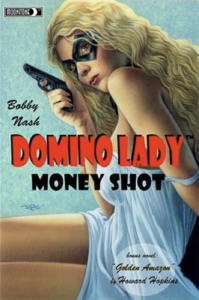
DCK: I appreciate you asking, but I really don’t have anything lingering on the sidelines. Most of my projects come about when I least expect it, like Mark calling me to work with him on his hard-boiled show. I ended up working with Apple TV Studios for four weeks.
Back in October, I worked four weeks with a restoration team on a 1970’s film that will be rereleased in 2023. I sat for hours digitally removing scratches and blemishes, frame by frame. That was a remarkable experience. I saw white dots and scratches in my dreams for weeks after!
I also have my monthly commissions that I work on. Those keep me fresh, and I am thankful to those collectors that like my work enough to continue to come back for more.
I teach part-time, as well as teach one-on-one sessions with advanced artists. Between all of that, drawing and painting, my weekly physical rehab visits, as well as family fun, I get down into my studio as often as possible. I will say: “I am in the studio,” and I draw and sketch. Most of the time those drawings turn into paintings.
Recently, I was talking to my friend, Thomas Blackshear, and he persuaded me to start a list of paintings that I want to do. It’s something that he has done and it’s working out great for him. So, at the moment, I have the shortlist and I am developing the thumbnails so that I can pull together my references. So, I can then choose the next painting to work on and everything is ready to go.
Want to learn more about Doug Klauba and his work? Doug’s official website is Douglas C. Klauba Artworks. He’s also on Facebook and Instagram. You’ll find his blog at The Shape of Things to Come. A Chicago native, Doug graduated from the American Academy of Art in Chicago in 1985. He also studied at the Academy of Art College in San Francisco. His illustrations have been commissioned for posters, advertising, book covers, magazines, corporate communications, calendars, and collector plates by various national and international agencies and design firms.
All of our images are the work of Douglas C. Klauba, including our featured image, excerpted from the cover art for Doc Savage: The Lost Radio Scripts of Lester Dent, Moonstone Books, hardcover edition, 2009. Also featured, from top to bottom: The Spider Chronicles, Moonstones Books, 2007; The Shadow Knows, art print, 2016; Doc Savage: The Lost Radio Scripts of Lester Dent, Moonstone Books, hardcover edition, 2009; Doc Savage: The Frightened Fish, by Will Murray, Moonstone Books, 2015; Secrets of the Nine: The Monster on Hold, by Philip José Farmer and Win Scott Eckert, Meteor House hardcover, 2021; Tarzan and the Forest of Stone, Jeffrey J. Mariotte, Edgar Rice Burroughs, Inc., 2022; The Adventures of Zana O’Savin #1 — The Blood Ogre, by Craig McDonald, Night Town Books, 2022 (plus preliminary drawing); Buck Rogers, Adler Planetarium and Space Museum, 2001; The Phantom, The Ghost Who Walks, Moonstone Comics, 2002; and The Domino Lady: Money Shot, by Bobby Nash, Moonstone Books, 2014.
Author of the Edgar-nominated Hector Lassiter historical crime series, Craig McDonald is an award-winning novelist, journalist, and editor. The Hector Lassiter series chronicles the exploits of a fictional Black Mask author and his encounters with such notable figures as Ernest Hemingway, Orson Welles, Ian Fleming, and Lester Dent. McDonald’s internationally acclaimed works have found a global audience and have also been adapted into graphic novel format. His works have been published by Simon & Schuster and Macmillan Press. His newest book is The Blood Ogre, the first in a new series called The Adventures of Zana O’Savin. A member of the PulpFest organizing committee and a regular contributor to our website and The Pulpster, you can read more about Craig on our PulpFest Committee page.
Watch for our next PulpFest Profile in March when Sara Light-Waller will talk with John Gunnison of Adventure House.

